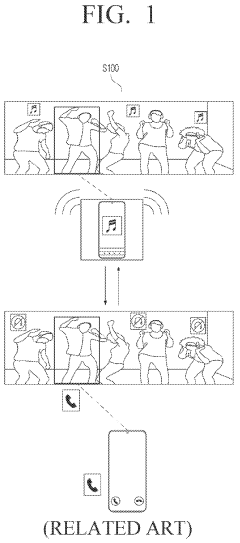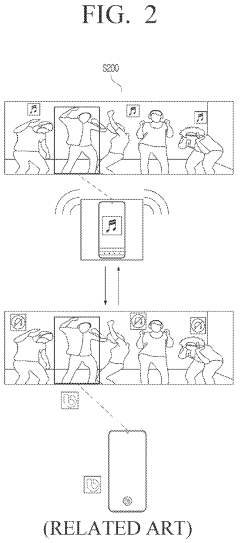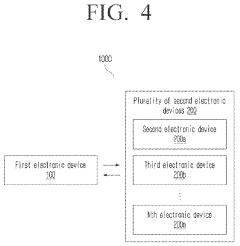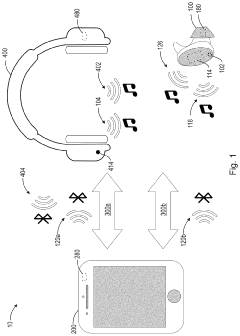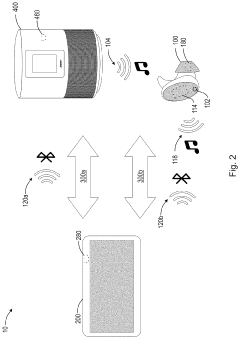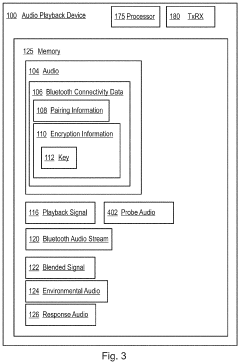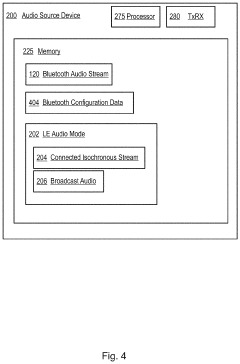How LDAC Enhances Bluetooth Audio Connections?
JUL 4, 20259 MIN READ
Generate Your Research Report Instantly with AI Agent
Patsnap Eureka helps you evaluate technical feasibility & market potential.
LDAC Technology Overview and Objectives
LDAC, developed by Sony in 2015, represents a significant leap forward in Bluetooth audio technology. This codec aims to address the limitations of traditional Bluetooth audio transmission, particularly in terms of sound quality and bandwidth utilization. LDAC's primary objective is to enable high-resolution audio streaming over Bluetooth connections, offering near CD-quality sound without the need for wired connections.
The technology behind LDAC is rooted in advanced audio compression algorithms that allow for efficient data transmission while maintaining audio fidelity. Unlike standard Bluetooth codecs such as SBC (Sub-Band Coding), LDAC can transmit up to 990 kbps of data, which is approximately three times the bitrate of conventional Bluetooth audio. This increased bandwidth enables the transmission of higher quality audio signals, preserving more of the original recording's detail and nuance.
LDAC's development was driven by the growing demand for high-fidelity audio in portable devices. As consumers increasingly rely on smartphones and wireless headphones for music consumption, the need for improved audio quality over Bluetooth connections has become more pronounced. LDAC addresses this need by offering three distinct bitrate modes: 330 kbps, 660 kbps, and 990 kbps, allowing for adaptability based on connection stability and device capabilities.
One of the key technical goals of LDAC is to minimize audio quality degradation during wireless transmission. This is achieved through a combination of efficient encoding techniques and adaptive bitrate selection. The codec dynamically adjusts its transmission parameters based on the current radio frequency (RF) environment, ensuring optimal performance even in challenging wireless conditions.
LDAC also aims to improve energy efficiency in Bluetooth audio devices. By optimizing the compression and transmission processes, the technology seeks to reduce power consumption without compromising audio quality. This is particularly important for battery-powered devices such as wireless headphones and portable speakers, where extended playback time is a critical factor.
The broader objective of LDAC technology is to bridge the gap between wired and wireless audio quality. By offering a wireless solution that can handle high-resolution audio formats, LDAC seeks to eliminate the need for separate high-fidelity wired systems in many listening scenarios. This aligns with the industry trend towards wireless audio solutions and the increasing popularity of high-resolution audio formats among audiophiles and casual listeners alike.
As the audio technology landscape continues to evolve, LDAC positions itself as a forward-looking solution, compatible with emerging audio standards and capable of supporting future advancements in audio quality. Its development reflects a commitment to enhancing the overall Bluetooth audio experience, setting new benchmarks for wireless audio transmission in terms of quality, efficiency, and user experience.
The technology behind LDAC is rooted in advanced audio compression algorithms that allow for efficient data transmission while maintaining audio fidelity. Unlike standard Bluetooth codecs such as SBC (Sub-Band Coding), LDAC can transmit up to 990 kbps of data, which is approximately three times the bitrate of conventional Bluetooth audio. This increased bandwidth enables the transmission of higher quality audio signals, preserving more of the original recording's detail and nuance.
LDAC's development was driven by the growing demand for high-fidelity audio in portable devices. As consumers increasingly rely on smartphones and wireless headphones for music consumption, the need for improved audio quality over Bluetooth connections has become more pronounced. LDAC addresses this need by offering three distinct bitrate modes: 330 kbps, 660 kbps, and 990 kbps, allowing for adaptability based on connection stability and device capabilities.
One of the key technical goals of LDAC is to minimize audio quality degradation during wireless transmission. This is achieved through a combination of efficient encoding techniques and adaptive bitrate selection. The codec dynamically adjusts its transmission parameters based on the current radio frequency (RF) environment, ensuring optimal performance even in challenging wireless conditions.
LDAC also aims to improve energy efficiency in Bluetooth audio devices. By optimizing the compression and transmission processes, the technology seeks to reduce power consumption without compromising audio quality. This is particularly important for battery-powered devices such as wireless headphones and portable speakers, where extended playback time is a critical factor.
The broader objective of LDAC technology is to bridge the gap between wired and wireless audio quality. By offering a wireless solution that can handle high-resolution audio formats, LDAC seeks to eliminate the need for separate high-fidelity wired systems in many listening scenarios. This aligns with the industry trend towards wireless audio solutions and the increasing popularity of high-resolution audio formats among audiophiles and casual listeners alike.
As the audio technology landscape continues to evolve, LDAC positions itself as a forward-looking solution, compatible with emerging audio standards and capable of supporting future advancements in audio quality. Its development reflects a commitment to enhancing the overall Bluetooth audio experience, setting new benchmarks for wireless audio transmission in terms of quality, efficiency, and user experience.
Market Demand for High-Quality Wireless Audio
The demand for high-quality wireless audio has been steadily increasing in recent years, driven by the growing popularity of mobile devices, smart speakers, and wireless headphones. Consumers are increasingly seeking audio experiences that rival or surpass traditional wired connections, expecting crystal-clear sound, minimal latency, and seamless connectivity across various devices.
The market for wireless audio devices has seen significant growth, with a particular emphasis on premium audio quality. This trend is evident in the rising sales of high-end wireless headphones and earbuds, which often feature advanced audio codecs like LDAC. The adoption of these technologies is not limited to audiophiles but has expanded to include everyday consumers who value superior sound quality in their daily audio experiences.
One of the key drivers of this market demand is the increasing consumption of streaming media. As more users turn to music streaming services, podcasts, and video platforms, there is a growing expectation for audio quality that matches the high-resolution content being delivered. This has led to a surge in demand for wireless audio solutions that can transmit high-bitrate audio without compromising quality.
The automotive industry has also contributed to the market demand for high-quality wireless audio. As car manufacturers integrate more advanced infotainment systems, there is a growing need for wireless audio technologies that can deliver premium sound quality within the vehicle environment. This has led to partnerships between audio technology companies and automobile manufacturers to implement advanced Bluetooth codecs in car audio systems.
Another factor influencing the market is the rise of virtual and augmented reality applications. These immersive experiences require high-fidelity audio to create a convincing sense of presence. As a result, there is an increasing demand for wireless audio solutions that can deliver low-latency, high-quality sound to complement these visual technologies.
The professional audio sector has also shown a growing interest in high-quality wireless audio solutions. Recording studios, live performance venues, and broadcast environments are exploring wireless options that can meet their stringent audio quality requirements. This has opened up new market opportunities for technologies like LDAC, which can potentially bridge the gap between professional-grade wired audio and wireless convenience.
Consumer awareness of audio quality has also been on the rise, partly due to marketing efforts by audio equipment manufacturers and streaming services. This increased awareness has led to a more discerning customer base, willing to invest in premium audio products that offer superior wireless performance. As a result, there is a growing market segment that specifically seeks out devices supporting advanced audio codecs like LDAC.
The market for wireless audio devices has seen significant growth, with a particular emphasis on premium audio quality. This trend is evident in the rising sales of high-end wireless headphones and earbuds, which often feature advanced audio codecs like LDAC. The adoption of these technologies is not limited to audiophiles but has expanded to include everyday consumers who value superior sound quality in their daily audio experiences.
One of the key drivers of this market demand is the increasing consumption of streaming media. As more users turn to music streaming services, podcasts, and video platforms, there is a growing expectation for audio quality that matches the high-resolution content being delivered. This has led to a surge in demand for wireless audio solutions that can transmit high-bitrate audio without compromising quality.
The automotive industry has also contributed to the market demand for high-quality wireless audio. As car manufacturers integrate more advanced infotainment systems, there is a growing need for wireless audio technologies that can deliver premium sound quality within the vehicle environment. This has led to partnerships between audio technology companies and automobile manufacturers to implement advanced Bluetooth codecs in car audio systems.
Another factor influencing the market is the rise of virtual and augmented reality applications. These immersive experiences require high-fidelity audio to create a convincing sense of presence. As a result, there is an increasing demand for wireless audio solutions that can deliver low-latency, high-quality sound to complement these visual technologies.
The professional audio sector has also shown a growing interest in high-quality wireless audio solutions. Recording studios, live performance venues, and broadcast environments are exploring wireless options that can meet their stringent audio quality requirements. This has opened up new market opportunities for technologies like LDAC, which can potentially bridge the gap between professional-grade wired audio and wireless convenience.
Consumer awareness of audio quality has also been on the rise, partly due to marketing efforts by audio equipment manufacturers and streaming services. This increased awareness has led to a more discerning customer base, willing to invest in premium audio products that offer superior wireless performance. As a result, there is a growing market segment that specifically seeks out devices supporting advanced audio codecs like LDAC.
Current Bluetooth Audio Codecs and Limitations
Bluetooth audio codecs play a crucial role in determining the quality of wireless audio transmission. Currently, several codecs are widely used in Bluetooth audio devices, each with its own strengths and limitations. The most common codecs include SBC, AAC, aptX, and LDAC.
SBC (Sub-Band Coding) is the mandatory codec for all Bluetooth audio devices. It offers basic audio quality and wide compatibility but suffers from lower bitrates and noticeable compression artifacts. SBC's maximum bitrate is limited to 328 kbps, which results in a loss of audio fidelity, particularly in high-frequency ranges.
AAC (Advanced Audio Coding) is primarily used in Apple devices and offers better audio quality than SBC. It supports bitrates up to 256 kbps and provides improved efficiency in audio compression. However, AAC's performance can vary significantly across different Android devices, leading to inconsistent audio quality.
aptX, developed by Qualcomm, aims to deliver CD-like audio quality over Bluetooth. It supports bitrates up to 352 kbps and offers lower latency compared to SBC. However, aptX is not universally supported across all devices and may require specific hardware implementations.
The limitations of these codecs become apparent when dealing with high-resolution audio files or demanding listening environments. They often struggle to maintain audio fidelity, especially in the higher frequency ranges, and can introduce noticeable compression artifacts. Additionally, the limited bandwidth of Bluetooth transmission poses challenges for delivering truly lossless audio quality.
Latency is another significant issue with current Bluetooth audio codecs. This delay between the audio signal being sent and received can be particularly problematic in gaming or video playback scenarios, where synchronization between audio and visual elements is crucial.
Furthermore, the power consumption of these codecs can be a concern, especially for portable devices with limited battery life. More complex codecs often require additional processing power, which can impact the overall energy efficiency of Bluetooth audio devices.
Compatibility issues also persist in the Bluetooth audio ecosystem. Not all codecs are supported by all devices, leading to situations where the audio quality may be compromised when pairing devices from different manufacturers or ecosystems.
These limitations have driven the development of more advanced codecs like LDAC, which aims to address many of these shortcomings by offering higher bitrates, improved audio quality, and better efficiency in audio transmission over Bluetooth connections.
SBC (Sub-Band Coding) is the mandatory codec for all Bluetooth audio devices. It offers basic audio quality and wide compatibility but suffers from lower bitrates and noticeable compression artifacts. SBC's maximum bitrate is limited to 328 kbps, which results in a loss of audio fidelity, particularly in high-frequency ranges.
AAC (Advanced Audio Coding) is primarily used in Apple devices and offers better audio quality than SBC. It supports bitrates up to 256 kbps and provides improved efficiency in audio compression. However, AAC's performance can vary significantly across different Android devices, leading to inconsistent audio quality.
aptX, developed by Qualcomm, aims to deliver CD-like audio quality over Bluetooth. It supports bitrates up to 352 kbps and offers lower latency compared to SBC. However, aptX is not universally supported across all devices and may require specific hardware implementations.
The limitations of these codecs become apparent when dealing with high-resolution audio files or demanding listening environments. They often struggle to maintain audio fidelity, especially in the higher frequency ranges, and can introduce noticeable compression artifacts. Additionally, the limited bandwidth of Bluetooth transmission poses challenges for delivering truly lossless audio quality.
Latency is another significant issue with current Bluetooth audio codecs. This delay between the audio signal being sent and received can be particularly problematic in gaming or video playback scenarios, where synchronization between audio and visual elements is crucial.
Furthermore, the power consumption of these codecs can be a concern, especially for portable devices with limited battery life. More complex codecs often require additional processing power, which can impact the overall energy efficiency of Bluetooth audio devices.
Compatibility issues also persist in the Bluetooth audio ecosystem. Not all codecs are supported by all devices, leading to situations where the audio quality may be compromised when pairing devices from different manufacturers or ecosystems.
These limitations have driven the development of more advanced codecs like LDAC, which aims to address many of these shortcomings by offering higher bitrates, improved audio quality, and better efficiency in audio transmission over Bluetooth connections.
LDAC Implementation and Technical Specifications
01 LDAC codec implementation for high-quality audio transmission
LDAC is a high-resolution audio codec developed for Bluetooth audio transmission. It enables the transfer of high-quality audio data at higher bit rates compared to standard codecs. The implementation of LDAC in audio devices allows for improved audio quality, wider frequency range, and better dynamic range in wireless audio streaming.- LDAC codec implementation for high-quality audio transmission: LDAC is a high-resolution audio codec developed for Bluetooth audio transmission. It enables the transfer of high-quality audio data at higher bit rates compared to standard codecs. The implementation of LDAC in audio devices can significantly improve the overall audio quality, providing a near lossless audio experience for users.
- Audio signal processing and enhancement for LDAC: Various signal processing techniques are employed to enhance the audio quality in LDAC-enabled devices. These may include noise reduction, dynamic range compression, and equalization. Advanced algorithms are used to optimize the audio signal before encoding, ensuring the best possible sound quality within the constraints of the LDAC codec.
- Adaptive bit rate and quality control in LDAC transmission: LDAC incorporates adaptive bit rate control mechanisms to maintain optimal audio quality under varying wireless conditions. The system can dynamically adjust the bit rate and encoding parameters based on the available bandwidth and connection stability, ensuring consistent high-quality audio playback.
- Integration of LDAC with audio playback systems: The integration of LDAC codec into various audio playback systems, including smartphones, wireless headphones, and home audio systems, is crucial for delivering high-quality audio. This involves optimizing hardware and software components to fully utilize LDAC's capabilities and ensure seamless compatibility across different devices.
- User experience and interface design for LDAC audio systems: Designing user-friendly interfaces and controls for LDAC-enabled audio devices is important for enhancing the overall user experience. This includes creating intuitive settings for audio quality selection, displaying real-time codec information, and providing user feedback on the audio quality being delivered through LDAC.
02 Audio signal processing for LDAC enhancement
Various signal processing techniques are employed to enhance the performance of LDAC audio. These may include noise reduction, echo cancellation, and adaptive equalization. Advanced algorithms are used to optimize the audio signal before encoding, ensuring the best possible quality when transmitted using the LDAC codec.Expand Specific Solutions03 LDAC integration with audio playback systems
LDAC codec is integrated into various audio playback systems, including smartphones, wireless speakers, and headphones. This integration involves hardware and software optimizations to ensure compatibility and optimal performance of LDAC-encoded audio across different devices and platforms.Expand Specific Solutions04 Quality assessment and optimization for LDAC audio
Methods and systems for assessing and optimizing the quality of LDAC-encoded audio are developed. These include real-time analysis of audio streams, adaptive bit rate adjustment, and perceptual quality evaluation techniques to ensure consistent high-quality audio output across various network conditions and device capabilities.Expand Specific Solutions05 LDAC compatibility with other audio technologies
Efforts are made to ensure LDAC's compatibility with other audio technologies and standards. This includes integration with various audio formats, support for multi-channel audio, and interoperability with different audio processing systems to provide a seamless high-quality audio experience across diverse audio ecosystems.Expand Specific Solutions
Key Players in Bluetooth Audio Technology
The LDAC Bluetooth audio technology market is in a growth phase, with increasing adoption across consumer electronics. The market size is expanding as more devices incorporate LDAC for high-quality wireless audio streaming. Technologically, LDAC is maturing but still evolving, with companies like Sony, Samsung, and LG Electronics leading development. Other key players include Qualcomm, MediaTek, and Huawei, who are integrating LDAC support into their chipsets and devices. While LDAC offers superior audio quality, its adoption is not yet universal, indicating room for further market penetration and technological refinement in the competitive Bluetooth audio landscape.
Samsung Electronics Co., Ltd.
Technical Solution: Samsung has incorporated LDAC support into its Galaxy series smartphones and various audio products. Their approach focuses on seamless integration and user experience. Samsung's implementation of LDAC allows for automatic switching between different Bluetooth codecs based on the connected device and audio content[8]. They have also developed their own Scalable Codec, which, while not LDAC, complements it by offering adaptive bit-rate from 88kbps to 512kbps[9]. This multi-codec approach ensures optimal audio quality across a wide range of scenarios and devices.
Strengths: Seamless user experience, wide ecosystem of compatible devices, adaptive codec switching. Weaknesses: Full benefits limited to Samsung's ecosystem.
QUALCOMM, Inc.
Technical Solution: Qualcomm has developed its own aptX adaptive codec to enhance Bluetooth audio connections. While not LDAC, it shares similar goals of improving wireless audio quality. The aptX adaptive codec dynamically adjusts bit rate, audio bandwidth, and bit depth based on the RF environment and audio content[2]. It supports 24-bit audio at sample rates up to 48kHz, with bitrates ranging from 279kbps to 420kbps[4]. Qualcomm's solution also includes low latency modes, crucial for gaming and video applications, with latencies as low as 50ms[5].
Strengths: Wide industry adoption, dynamic adaptation to RF conditions, low latency support. Weaknesses: Proprietary technology, requiring specific hardware support.
Core Innovations in LDAC Codec
Method and electronic device for Bluetooth audio multi-streaming
PatentActiveUS11985173B2
Innovation
- The implementation of a method and electronic device that establish a Broadcast Isochronous Group (BIG) and a Connected Isochronous Group (CIG) to enable concurrent routing of LE broadcast media audio and unicast conversational audio, allowing for simultaneous music broadcast and call processing by designating a primary headset for CIG data transfer, and dynamically adjusting LE audio Codec parameters and Quality of Service (QoS) configurations based on the Bluetooth link environment.
Audio-based near field communication
PatentActiveUS20230185520A1
Innovation
- The use of audio-based near field communication, where an audio playback device receives audio encoded with Bluetooth connectivity information and extracts it to form a Bluetooth connection with an audio source device, enabling synchronized listening experiences across multiple devices.
Compatibility and Adoption Challenges
Despite the significant advantages LDAC brings to Bluetooth audio connections, its widespread adoption faces several compatibility and implementation challenges. One of the primary hurdles is the limited device support for LDAC technology. While Sony, the developer of LDAC, has made it available to other manufacturers, not all devices have integrated this codec into their hardware and software systems. This lack of universal support creates fragmentation in the market, where consumers may find that their LDAC-enabled devices cannot fully utilize the technology when paired with non-compatible equipment.
Another challenge lies in the increased power consumption associated with LDAC's high-bitrate transmission. The codec's ability to transfer large amounts of data quickly comes at the cost of higher energy usage, which can impact battery life on both the transmitting and receiving devices. This power drain may deter some manufacturers from implementing LDAC, especially in smaller or more power-sensitive devices where battery longevity is a critical selling point.
The complexity of LDAC's adaptive bitrate system also presents challenges for seamless integration across various devices and operating systems. While the ability to adjust bitrates based on connection quality is a significant advantage, it requires sophisticated software management to ensure optimal performance. This complexity can lead to implementation difficulties and potential compatibility issues, particularly when dealing with diverse hardware configurations and software ecosystems.
Furthermore, the adoption of LDAC is influenced by licensing and royalty considerations. Although Sony has made LDAC available as part of the Android Open Source Project, there may still be costs associated with its implementation in commercial products. These financial factors can impact the decision-making process for manufacturers, especially in the competitive and cost-sensitive consumer electronics market.
Lastly, the presence of competing high-quality Bluetooth codecs, such as aptX HD and AAC, creates a fragmented landscape for audio transmission standards. This diversity can lead to consumer confusion and hesitation in adopting LDAC-enabled devices, as they may be unsure about long-term support and compatibility across their existing and future audio equipment. The challenge for LDAC lies not only in proving its technical superiority but also in establishing itself as a widely accepted and enduring standard in the Bluetooth audio ecosystem.
Another challenge lies in the increased power consumption associated with LDAC's high-bitrate transmission. The codec's ability to transfer large amounts of data quickly comes at the cost of higher energy usage, which can impact battery life on both the transmitting and receiving devices. This power drain may deter some manufacturers from implementing LDAC, especially in smaller or more power-sensitive devices where battery longevity is a critical selling point.
The complexity of LDAC's adaptive bitrate system also presents challenges for seamless integration across various devices and operating systems. While the ability to adjust bitrates based on connection quality is a significant advantage, it requires sophisticated software management to ensure optimal performance. This complexity can lead to implementation difficulties and potential compatibility issues, particularly when dealing with diverse hardware configurations and software ecosystems.
Furthermore, the adoption of LDAC is influenced by licensing and royalty considerations. Although Sony has made LDAC available as part of the Android Open Source Project, there may still be costs associated with its implementation in commercial products. These financial factors can impact the decision-making process for manufacturers, especially in the competitive and cost-sensitive consumer electronics market.
Lastly, the presence of competing high-quality Bluetooth codecs, such as aptX HD and AAC, creates a fragmented landscape for audio transmission standards. This diversity can lead to consumer confusion and hesitation in adopting LDAC-enabled devices, as they may be unsure about long-term support and compatibility across their existing and future audio equipment. The challenge for LDAC lies not only in proving its technical superiority but also in establishing itself as a widely accepted and enduring standard in the Bluetooth audio ecosystem.
Energy Efficiency Considerations
Energy efficiency is a critical consideration in the development and implementation of LDAC technology for enhancing Bluetooth audio connections. As wireless audio devices continue to proliferate, the demand for longer battery life and reduced power consumption has become increasingly important. LDAC addresses these concerns through several innovative approaches.
One of the key energy efficiency features of LDAC is its adaptive bit rate mechanism. This system allows the codec to dynamically adjust the transmission rate based on the available bandwidth and signal strength. By optimizing the data transfer process, LDAC reduces unnecessary power consumption that would otherwise occur when transmitting at a constant high bit rate, even in suboptimal conditions.
LDAC also employs advanced signal processing techniques to minimize the computational load on both the transmitting and receiving devices. This optimization reduces the overall power consumption required for encoding and decoding audio streams. The efficient algorithms used in LDAC allow for high-quality audio transmission while maintaining a balance between performance and energy usage.
The technology incorporates power-saving modes that can be activated during periods of low audio complexity or when battery levels are critical. These modes intelligently scale back certain audio processing features without significantly compromising the listening experience, thereby extending the operational time of Bluetooth audio devices.
Furthermore, LDAC's efficient use of the Bluetooth radio spectrum contributes to energy conservation. By maximizing the amount of audio data transmitted per radio usage, LDAC reduces the frequency and duration of active radio transmissions, which are typically power-intensive operations in wireless devices.
The codec's ability to maintain high audio quality at lower bit rates also plays a role in energy efficiency. This capability allows devices to transmit high-fidelity audio while using less bandwidth, which in turn requires less power for data transmission and processing.
LDAC's energy efficiency considerations extend to its implementation in hardware as well. The technology is designed to be compatible with low-power microprocessors and digital signal processors, enabling manufacturers to create Bluetooth audio devices with smaller batteries without sacrificing audio quality or playback time.
As the demand for wireless audio solutions continues to grow, the energy efficiency of LDAC positions it as a forward-thinking technology in the Bluetooth audio ecosystem. Its ability to balance high-quality audio transmission with power conservation addresses a critical need in the market for portable and wearable audio devices, contributing to improved user experiences and longer device lifespans.
One of the key energy efficiency features of LDAC is its adaptive bit rate mechanism. This system allows the codec to dynamically adjust the transmission rate based on the available bandwidth and signal strength. By optimizing the data transfer process, LDAC reduces unnecessary power consumption that would otherwise occur when transmitting at a constant high bit rate, even in suboptimal conditions.
LDAC also employs advanced signal processing techniques to minimize the computational load on both the transmitting and receiving devices. This optimization reduces the overall power consumption required for encoding and decoding audio streams. The efficient algorithms used in LDAC allow for high-quality audio transmission while maintaining a balance between performance and energy usage.
The technology incorporates power-saving modes that can be activated during periods of low audio complexity or when battery levels are critical. These modes intelligently scale back certain audio processing features without significantly compromising the listening experience, thereby extending the operational time of Bluetooth audio devices.
Furthermore, LDAC's efficient use of the Bluetooth radio spectrum contributes to energy conservation. By maximizing the amount of audio data transmitted per radio usage, LDAC reduces the frequency and duration of active radio transmissions, which are typically power-intensive operations in wireless devices.
The codec's ability to maintain high audio quality at lower bit rates also plays a role in energy efficiency. This capability allows devices to transmit high-fidelity audio while using less bandwidth, which in turn requires less power for data transmission and processing.
LDAC's energy efficiency considerations extend to its implementation in hardware as well. The technology is designed to be compatible with low-power microprocessors and digital signal processors, enabling manufacturers to create Bluetooth audio devices with smaller batteries without sacrificing audio quality or playback time.
As the demand for wireless audio solutions continues to grow, the energy efficiency of LDAC positions it as a forward-thinking technology in the Bluetooth audio ecosystem. Its ability to balance high-quality audio transmission with power conservation addresses a critical need in the market for portable and wearable audio devices, contributing to improved user experiences and longer device lifespans.
Unlock deeper insights with Patsnap Eureka Quick Research — get a full tech report to explore trends and direct your research. Try now!
Generate Your Research Report Instantly with AI Agent
Supercharge your innovation with Patsnap Eureka AI Agent Platform!
